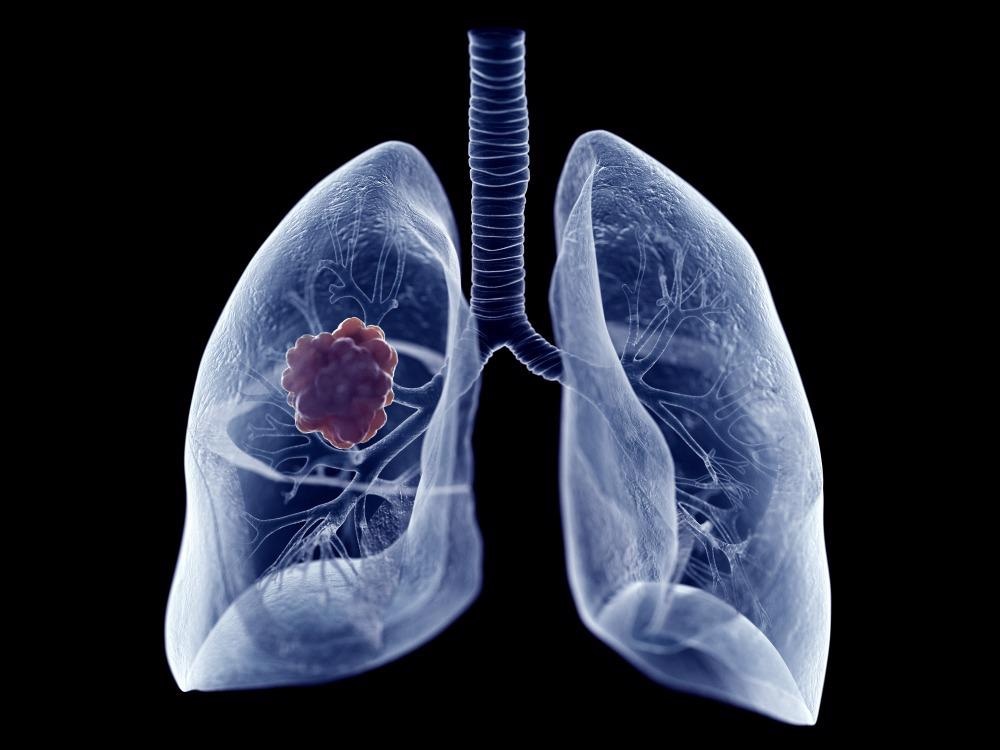In an article recently published in the journal ACS Applied Materials and Interfaces, the authors reported a nanoplatform (UCNP/Ce6@mMnO2/DSP-TFA) applied to treat non-small cell lung cancer-spinal metastasis (NSCLC-SM).

Study: Hybrid Mesoporous MnO2-Upconversion Nanoparticles for Image-Guided Lung Cancer Spinal Metastasis Therapy. Image Credit: SciePro/Shutterstock.com
The team developed a facile, quick, and universal method for coating upconversion nanoparticles (UCNPs) with mesoporous manganese dioxide (mMnO2) using polyethyleneimine (PEI) and potassium permanganate (KMnO4) as a reducing agent and source of manganese (Mn), respectively.
The as-prepared mMnO2-coated UCNPs (UCNP@mMnO2) were surface modified with chlorin e6 (Ce6) photosensitizer, tumor-targeting pentapeptide (TFA), and cisplatin drug (DSP).
MnO2-Coated UNCPs
MnO2-based nanomaterials are known for their oxygen production, magnetic resonance imaging, tumor microenvironment (TME) response, and fluorescence quenching. Thus, MnO2-based nanomaterials have plenty of applications in biomedicine. Further, MnO2 is integrated with different functional materials to prepare a single nanoplatform whose demand lies in constructing composite materials with broad application prospects. However, there are no previous reports on a universal procedure for uniform coating of MnO2 on a nanomaterial's surface.
UCNPs and MnO2-based composite materials have recently found applications in tumor therapy, drug delivery, and biosensing. However, the mMnO2 coating on the UCNP surface impedes the controlled release of therapy material. Although many antecedents report various attempts to coat MnO2 on UCNP, they have limitations. Hence, researchers explore a controllable and facile method to synthesize MnO2-shell on composite materials for their biological applications.
NSCLC-SM Targeting Novel Nanoplatform
In the present study, the authors reported a new strategy to prepare MnO2 nanomaterials by reducing KMnO4 using water-soluble PEI. The facile and reproducible method facilitates the regulation of MnO2 thickness accurately. Further, the synthesized UCNP@mMnO2 was modified to construct the UCNP/Ce6@mMnO2/DSP-TFA (U6MDT) nanoplatform.
The imaging and photodynamic therapy (PDT) with separate near-infrared (NIR) light sources use UCNPs with a core-shell-shell-shell construction, sodium erbium fluoride, sodium yttrium fluoride, sodium erbium fluoride: 5% neodymium-coated sodium yttrium fluoride (NaErF4@NaYF4@NaYF4: 5%Nd@NaYF4). This nanomaterial core's downconversion luminescence (DCL) located in NIR-II (730 nanometers) can monitor the accumulation of tumors.
Moreover, UCL (656 nanometers) activated photosensitizer Ce6 was used to obtain PDT at 980-nanometer laser irradiations. Cisplatin (DSP) loaded on mMnO2 shell interacts with the TEM for efficient combination therapy of PDT-chemotherapy. The spine is the common site for NSCLC metastasis (NSCLC-SM), which was used as a biological model for tumor therapy. The mMnO2 shell attached peptide targeted NSCLC-SM, confirming the efficiency of the nanotherapeutic agent in treating NSCLC-SM.
Research Findings
The results obtained from field emission scanning electron microscopy (FESEM) and scanning transmission electron microscopy (STEM) studies confirmed the successful coating of mMnO2 on UCNP. The data obtained from energy dispersive spectroscopy (EDS) elemental mapping revealed the uniform distribution of sodium (Na), fluorine (F), erbium (Er), oxygen (O), neodymium (Nd), yttrium (Y), and Mn elements.
The mechanism of mMnO2 coating to form UM (UCNP@mMnO2) was studied using Fourier transform infrared (FT-IR), ultraviolet−visible (UV-Vis) absorption spectra, X-ray photoelectron spectroscopy (XPS), X-ray diffraction (XRD), and zeta potential measurements.
The results obtained from zeta potential, FT-IR spectra, UV−vis absorption spectra measurements, and EDS data showed successful preparation of the U6MDT platform. Further, results from EDS evaluation and UV−vis spectra confirmed the loading efficiency of Ce6 (38%) and DSP (28%).
Dissolution of mMnO2 in TME mimicking solution followed by assessment with inductively coupled plasma-atomic emission spectroscopy (ICP-AES) revealed that 100% Mn2+ are released in 60 minutes.
In vitro studies performed to evaluate photodynamic activity, biosafety, and anti-tumor efficiency of U6MDT revealed the cellular uptake of U6MDT and its biosafety. Further, the in vivo studies conducted to analyze the biodistribution and therapeutic efficiency of U6MDT on NSCLC-SM showed that compared to DSP, Ce6-TFA, and UMDT groups, U6MT showed better anti-tumor activity.
Conclusion
To conclude, the synthesized mMnO2 reported in this study can be used on various nanomaterials to construct highly functionalized composite materials. The nanoplatform UCNP@mMnO2 was modified into therapeutic nanoplatform UCNP/Ce6@mMnO2/DSP-TF (U6MDT), which exhibited TME-specific response on irradiating with both DCL and UCL luminescence.
Accumulated nanomaterials were traced at the tumor site using NIR-II imaging of DCL on NSCLC-SM mouse models and irradiation at 730 nanometers. TME triggered the degradation of the mMnO2 shell and released DSP at the tumor site. Further, to achieve the efficient combination therapy of PDT−chemotherapy, PDT can be excited under 980 nanometers. The novel nanoplatform U6MDT exhibited good potency against tumors in mouse models with NSCLC-SM. The present work showcases the impact of mMnO2 surface coating on nanomaterials to develop functionalized composite materials.
Reference
Han, X., Zhou, L., Zhuang, H., Wei, P., Li, F., Jiang, L., & Yi, T. (2022). Hybrid Mesoporous MnO2-Upconversion Nanoparticles for Image-Guided Lung Cancer Spinal Metastasis Therapy. ACS Applied Materials & Interfaces.https://pubs.acs.org/doi/10.1021/acsami.1c22322
Disclaimer: The views expressed here are those of the author expressed in their private capacity and do not necessarily represent the views of AZoM.com Limited T/A AZoNetwork the owner and operator of this website. This disclaimer forms part of the Terms and conditions of use of this website.